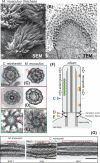IFT-Cargo Interactions and Protein Transport in Cilia
- PMID: 26498262
- PMCID: PMC4661101
- DOI: 10.1016/j.tibs.2015.09.003
IFT-Cargo Interactions and Protein Transport in Cilia
Abstract
The motile and sensory functions of cilia and flagella are indispensable for human health. Cilia assembly requires a dedicated protein shuttle, intraflagellar transport (IFT), a bidirectional motility of multi-megadalton protein arrays along ciliary microtubules. IFT functions as a protein carrier delivering hundreds of distinct proteins into growing cilia. IFT-based protein import and export continue in fully grown cilia and are required for ciliary maintenance and sensing. Large ciliary building blocks might depend on IFT to move through the transition zone, which functions as a ciliary gate. Smaller, freely diffusing proteins, such as tubulin, depend on IFT to be concentrated or removed from cilia. As I discuss here, recent work provides insights into how IFT interacts with its cargoes and how the transport is regulated.
Keywords: diffusion; dynein; flagella; intraflagellar transport; kinesin-2; microtubule; tubulin.
Copyright © 2015 Elsevier Ltd. All rights reserved.
Figures




References
-
- Gealt MA, Adler JH, Nes WR. The sterol and fatty acids from purified flagella of Chlamydomonas reinhardtii. Lipids. 1981;16:133–136.
-
- Ostrowski LE, Blackburn K, Radde KM, Moyer MB, Schlatzer DM, Moseley A, Boucher RC. A proteomic analysis of human cilia: identification of novel components. Molecular & cellular proteomics : MCP. 2002;1:451–465. - PubMed
Publication types
MeSH terms
Substances
Grants and funding
LinkOut - more resources
Full Text Sources
Other Literature Sources
Research Materials

